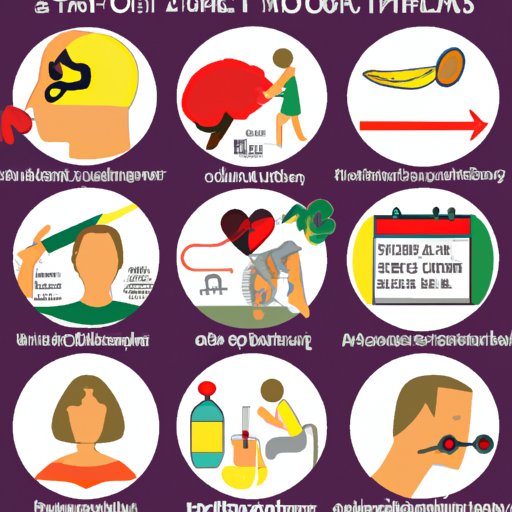I. Introduction
Stroke, a medical emergency caused by an interruption of the blood flow to the brain, is a leading cause of death and disability worldwide. While some risk factors like age, family history, and genetics cannot be controlled, certain lifestyle changes could significantly lower one’s risk of having a stroke. In this article, we will explore lifestyle factors, warning signs, risk factors, the role of diet, medical treatments and interventions, and personal tips for preventing stroke, providing our readers with a comprehensive guide to a healthy lifestyle.
II. Lifestyle Factors that Can Help Prevent Stroke
The way we live our lives can have a significant impact on our risk of developing stroke. Here are some lifestyle factors that could help prevent stroke:
- Maintaining a healthy diet: Eating a balanced diet rich in fruits, vegetables, whole grains, and lean protein could reduce your risk of stroke. Avoiding processed foods, excess sodium, and saturated fats is recommended.
- Regular exercise: Engaging in moderate-intensity physical activities like brisk walking, jogging, swimming, or cycling for at least 30 minutes a day could maintain your cardiovascular health and reduce your risk of stroke and other chronic diseases.
- Getting enough sleep: Not getting enough sleep could increase your risk of stroke. Most adults need seven to eight hours of sleep per night.
- Reducing stress: Chronic stress has been linked to hypertension and other cardiovascular diseases. Practising relaxation techniques like deep breathing, meditation, yoga, or tai chi could mitigate your stress levels and enhance your overall well-being.
III. Warning Signs and Risk Factors for Stroke
Knowing the warning signs and risk factors for stroke could help you take prompt action to prevent a stroke from occurring. Here are some warning signs to watch for:
- numbness or weakness in the face, arm, or leg, especially on one side of the body
- confusion, trouble speaking, or difficulty understanding speech
- trouble seeing in one or both eyes
- difficulty walking, dizziness, or loss of balance or coordination
- severe headache with no known cause
Common risk factors for stroke include:
- high blood pressure or hypertension
- smoking or exposure to secondhand smoke
- diabetes
- high cholesterol
- lack of physical activity
- obesity
To reduce your risk of stroke, follow these simple steps:
- Visit your doctor regularly to monitor your blood pressure, blood glucose, and cholesterol levels.
- If you smoke, quit. If you don’t smoke, avoid exposure to secondhand smoke.
- Exercise regularly and maintain a healthy weight.
- Follow a balanced diet low in saturated fats, trans fats, and salt.
- Limit your alcohol intake.
- Manage any medical conditions, including hypertension, diabetes, and heart disease, with your doctor’s guidance.
IV. The Role of Diet in Stroke Prevention
Diet is a crucial component of stroke prevention. Here are some foods and nutrients that may reduce your risk of stroke:
- Fruits and vegetables: Eating a variety of colorful fruits and veggies could provide you with essential vitamins, minerals, and antioxidants that could promote your cardiovascular health. Leafy greens, citrus fruits, berries, and cruciferous vegetables are particularly beneficial.
- Whole grains: Whole grains like brown rice, quinoa, and oatmeal could lower your risk of stroke and other chronic diseases. They are rich in fiber, vitamins, minerals, and antioxidants.
- Fatty fish: Fatty fish like salmon, mackerel, and trout are rich in omega-3 fatty acids, which could reduce inflammation, lower blood pressure, and prevent blood clots.
- Nuts and seeds: Nuts and seeds are rich in unsaturated fats, fiber, and protein, which could improve your blood lipid profile and reduce your risk of stroke. Walnuts, almonds, chia seeds, and flaxseeds are recommended.
On the other hand, certain foods could increase your risk of stroke. These include:
- sodium-rich foods like canned soups, processed meats, and fast food
- sugar-sweetened beverages like soda, energy drinks, and sweet tea
- trans fats found in margarine, fried foods, and pastry
V. Medical Treatments and Interventions That Can Help Prevent Stroke
While lifestyle factors and dietary changes could help lower your risk of stroke, medical treatments and interventions could also play a critical role in stroke prevention. Here are some options your doctor may recommend:
- Medication: Depending on your medical history and condition, your doctor may prescribe medications like blood thinners, antihypertensives, or cholesterol-lowering drugs to reduce your risk of stroke.
- Surgery: In some cases, surgery to open blocked arteries or repair aneurysms could prevent stroke from happening.
- Other interventions: Lifestyle changes like increasing physical activity, quitting smoking, and losing weight could complement medical therapies and improve your overall health. Your doctor may also recommend physical therapy, speech therapy, or occupational therapy to help you recover from a stroke or manage its aftermath.
VI. Personal Tips and Stories for Stroke Prevention
Preventing stroke is a complex process that involves not only medical knowledge but also personal motivation, support, and perseverance. Here are some personal tips and stories from stroke survivors, caregivers, and experts:
- “After my stroke, I realized how precious life is. I started to eat healthier, walk more, and spend more time with my family. Don’t wait for a stroke to wake you up. Start living now!” – a stroke survivor
- “As a caregiver, I’ve learned that stroke recovery is not just physical but also emotional and social. Supporting your loved one and encouraging them to stay engaged and active could make a huge difference.” – a caregiver
- “Stroke prevention requires a multi-faceted approach that addresses individual needs and challenges. Partnering with health professionals, family members, and community resources could provide you with the resources and support you need.” – a health expert
VII. Conclusion
Preventing stroke is everyone’s responsibility. By following a healthy lifestyle, recognizing warning signs and risk factors, monitoring your health, and seeking medical care as needed, you could minimize your risk of stroke and live a happier, healthier life. Remember, stroke is preventable.
